Development of Novel Thermal Diffusivity Analysis by Spot Periodic Heating and Infrared Radiation Thermometer Method
Abstract
1. Introduction
- The distribution of the intensity of the heating laser beam and the intensity of the infrared detector cannot be ignored.
- The effect of the reflection of temperature waves from the upper and lower surface cannot be ignored.
2. Materials and Methods
3. Results and Discussion
3.1. Evaluation of Gaussian Distribution of Laser
3.2. Spatial Sensitivity Distribution of Detector
3.3. Thermal Diffusivity Analysis Method Using Contour Plot
- The range, where the phase lag shows good linearity with respect to the distance l, was determined.
- A numerical table of the ratio of the true values of thermal diffusivity and the thermal diffusivity which were calculated by Equation (3) using the phase lag obtained by the calculation were prepared.
- An arbitrary analysis distance is decided, and the intersection of contour lines of a point obtained by an apparent thermal diffusivity obtained from an arbitrary analysis distance and a line drawn to the thickness of the measurement sample are compared.
- The analysis distance is set to a more appropriate distance. This operation is carried out until the apparent thermal diffusivity value that can be obtained converges.
- An actual thermal diffusivity is obtained by using the apparent coefficient of thermal diffusivity obtained by using the correction coefficient given by Figure 6b. The correction factor given is the value of the contour line present at the intersection of the line drawn to the thickness of the measurement sample and the point given by the thermal diffusivity obtained from the appropriate analysis distance.
3.4. Evaluation of Thermal Diffusivity for Copper Samples
- As shown by line (I) in Figure 7, the tentative thermal diffusivity α’I, which was estimated to be 1.23 × 10−4 m2s−1, was derived from the slope of the phase lag using Equation (3) in the range of the tentative analysis distance lI = 0–1 mm.
- In the results from α’I/f and thickness of sample d (See line (I) in Figure 6), the approximate analytical distance was obtained to be lII = 0.58–1.58 mm.
- As shown by line (II) in Figure 7, the tentative thermal diffusivity α’II, which was estimated to be 1.06 × 10−4 m2s−1, was derived from the slope of the phase lag using Equation (3).
- In the results of α’I/f and thickness of sample d (See line (II) in Figure 6), the tentative analytical distance was lII = 0.59–1.59 mm.
- In line (II) and (III) in Figure 7, the phase lag in the range of lIII was equal to that in the range of lII. Thus, the evaluated value was converged at this stage.
- In line (IV) in Figure 6, the correction factor, using the tentative thermal diffusivity α’III, thickness of sample d, heating frecuancy f, and applied correction factor to α’III, was evaluated to be 1.14. In these results, the actual thermal diffusivity of pure copper was 1.18 × 10−4 m2s−1. This value is in good agreement with the literature value (1.17 × 10−4 m2s−1).
4. Conclusions
- We examined the thermal diffusion evaluation method using a parameter table based on heat transfer equations using the concept of optimum distance between heating-point and measurement point.
- In the results of the thermal diffusivity analysis, the thermal diffusivity of pure copper was 1.18 × 10−4 m2s−1. This value is in good agreement with previous studies.
- The accuracy of the novel thermal diffusivity analysis was estimated to be ±3%.
Author Contributions
Funding
Acknowledgments
Conflicts of Interest
References
- Wolf, A.; Pohl, P.; Brendel, R. Thermophysical analysis of thin films by lock-in thermography. J. Appl. Phys. 2004, 96, 6306–6312. [Google Scholar] [CrossRef]
- Hou, J.; Wang, X.; Guo, J. Thermal characterization of micro/nanoscale conductive and non-conductive wires based on optical heating and electrical thermal sensing. J. Phys. D Appl. Phys. 2006, 39, 3362–3370. [Google Scholar] [CrossRef][Green Version]
- Mendioroz, A.; Fuente-Dacal, R.; Apiñaniz, E.; Salazar, A. Thermal diffusivity measurements of thin plates and filaments using lock-in thermography. Rev. Sci. Instrum. 2009, 80, 074904. [Google Scholar] [CrossRef] [PubMed]
- Salazar, A.; Mendioroz, A.; Fuente, R. The strong influence of heat losses on the accurate measurement of thermal diffusivity using lock-in thermography. Appl. Phys. Lett. 2009, 95, 121905. [Google Scholar] [CrossRef]
- Philipp, A.; Pech-May, N.W.; Kopera, B.A.F.; Lechner, A.M.; Rosenfeldt, S.; Retsch, M. Direct Measurement of the in-Plane Thermal Diffusivity of Semitransparent Thin Films by Lock-In Thermography: An Extension of the Slopes Method. Anal. Chem. 2019, 91, 8476–8483. [Google Scholar] [CrossRef] [PubMed]
- Hahn, J.; Reid, T.; Marconnet, A. Infrared Microscopy Enhanced Ångström’s Method for Thermal Diffusivity of Polymer Monofilaments and Films. J. Heat Trans. 2019, 141, 081601. [Google Scholar] [CrossRef]
- Kato, H.; Baba, T.; Okaji, M. Anisotropic thermal-diffusivity measurements by a new laser-spot-heating technique. Meas. Sci. Technol. 2001, 12, 2074–2080. [Google Scholar] [CrossRef]
- Kato, H. Measurement Technology on Thermophysical Properties of Solid Materials by Laser-Spot-Heating Method. Netsu Bussei 2001, 15, 95–103. [Google Scholar]
- Kawahara, Y.; Iwata, H.; Hagino, H.; Miyazaki, K. 110 Measurements of in-Plane Thermal Conductivities of Si Thin Films by Periodic Laser Heating. Proc. Conf. Kyushu Branch 2013, 66, 19–20. [Google Scholar] [CrossRef]
- Hayashi, T.; Nishi, T.; Ohta, H.; Hatori, K.; Noguchi, H. Thermal Diffusivity Distribution Measurements of a High-Thermal-Conductive Heat Dissipating Sheet. J. Jpn. Inst. Met. 2018, 82, 396–399. [Google Scholar] [CrossRef]
- Ohta, H.; Shibata, H.; Waseda, Y. New attempt for measuring thermal diffusivity of thin films by means of a laser flash method. Rev. Sci. Instrum. 1989, 60, 317–321. [Google Scholar] [CrossRef]
- Ikeuchi, S.; Shimada, K. Evaluation of Thermophysical Properties of out-of-Plane Direction of Thin Films by a Perodic Heating Method. Netsu Sokutei 2014, 41, 60–65. [Google Scholar]
- Nagano, H.; Kuribara, M.; Ohno, S. Yasushi Nishikawa, Measurement of in−plane Therma1 Diffusivity for High−Thermal−Conductive Materials using a Laser−Spot Periodic Heating Method. Jpn. Soc. Mech. Eng. 2012, 11, 17–18. [Google Scholar]
- Nagata, S.; Miyake, S.; Ozaki, J. Thermal Orientation Evaluation for Carbon-fiber-reinforced Plastic by Periodic Heating Method. Sens. Mater. 2019, 31, 763. [Google Scholar] [CrossRef]
- Nagashima, A.; Araki, N.; Baba, T. Thermophysical Properties Handbook; Nagashima, A., Ed.; Yokendo: Tokyo, Japan, 2007; p. 23. (In Japanese) [Google Scholar]
- Carslaw, H.S.; Jaeger, J.C. Conduction of Heat in Solids; Oxford Science Publications: Oxford, UK, 1959; p. 263. [Google Scholar]
- Nakano, W.; Morishita, K.; Matsui, G.; Yagi, T.; Ohta, H. スポット加熱オングストローム法による板状試料の内部温度分布および位相分布の数値シミュレーションと熱拡散率の導出. In Proceedings of the 31st Japan Symposium on Thermophysical Properties, Hukuoka, Japan, 19 November 2010; Volume 31, pp. 261–263. [Google Scholar]
- Piessens, R. The Hankel Transform. In The Transforms and Applications Handbook, 2nd ed.; Alexander, D., Ed.; CRC Press LLC: Boca Raton, FL, USA, 2000. [Google Scholar]
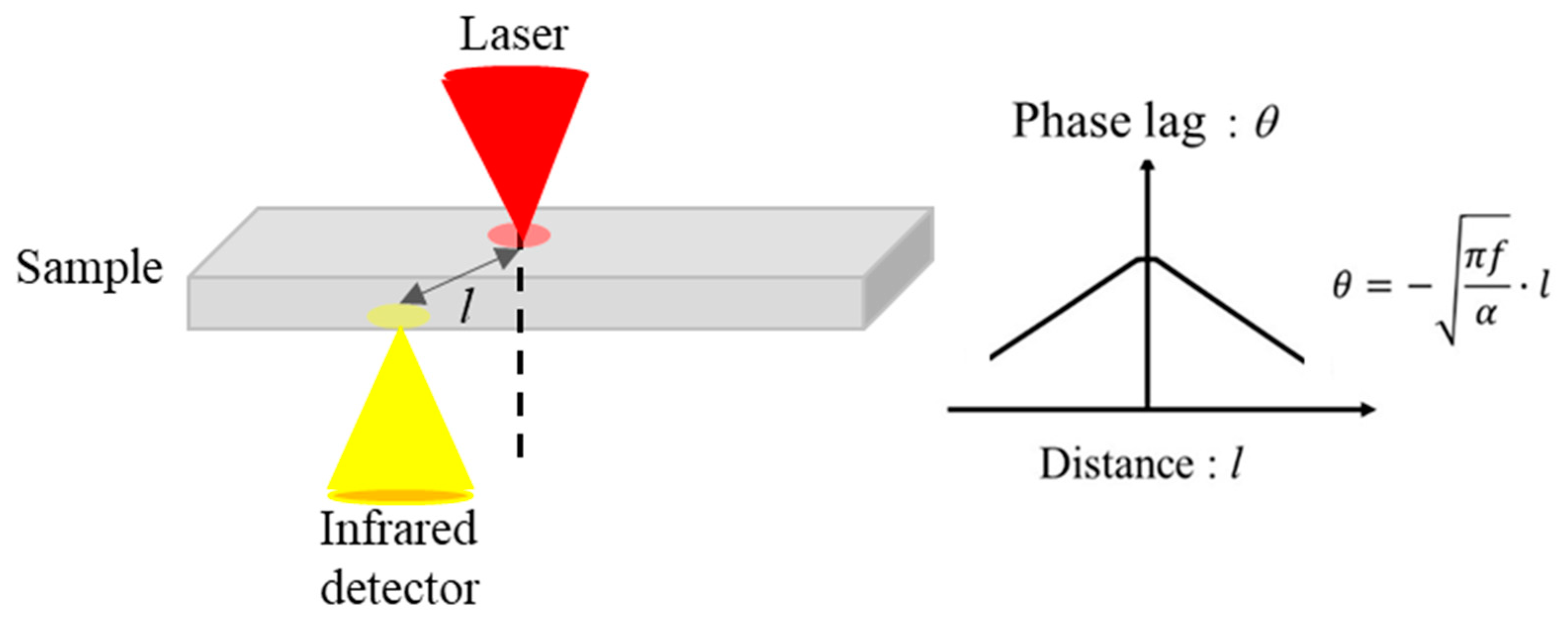
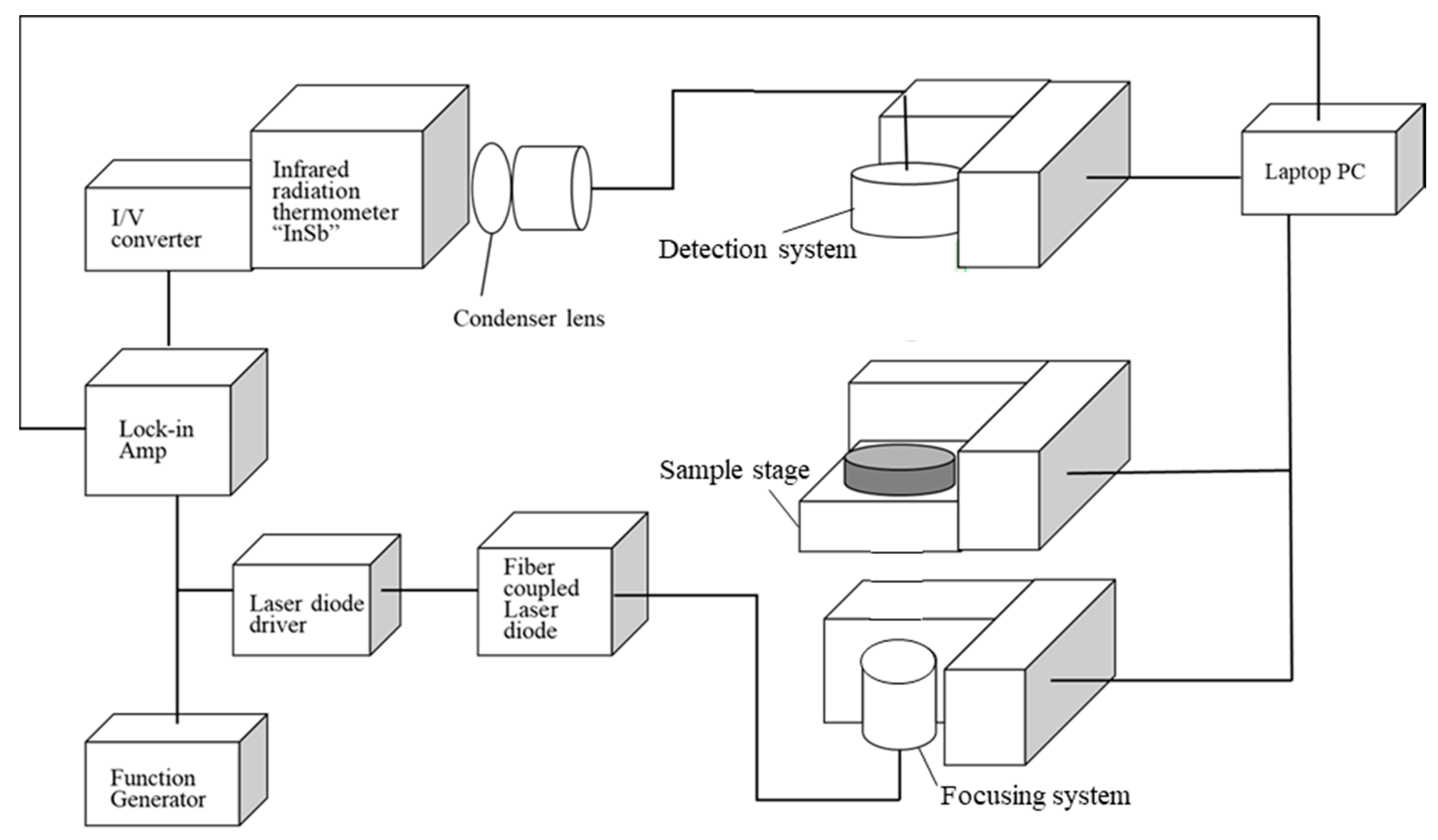

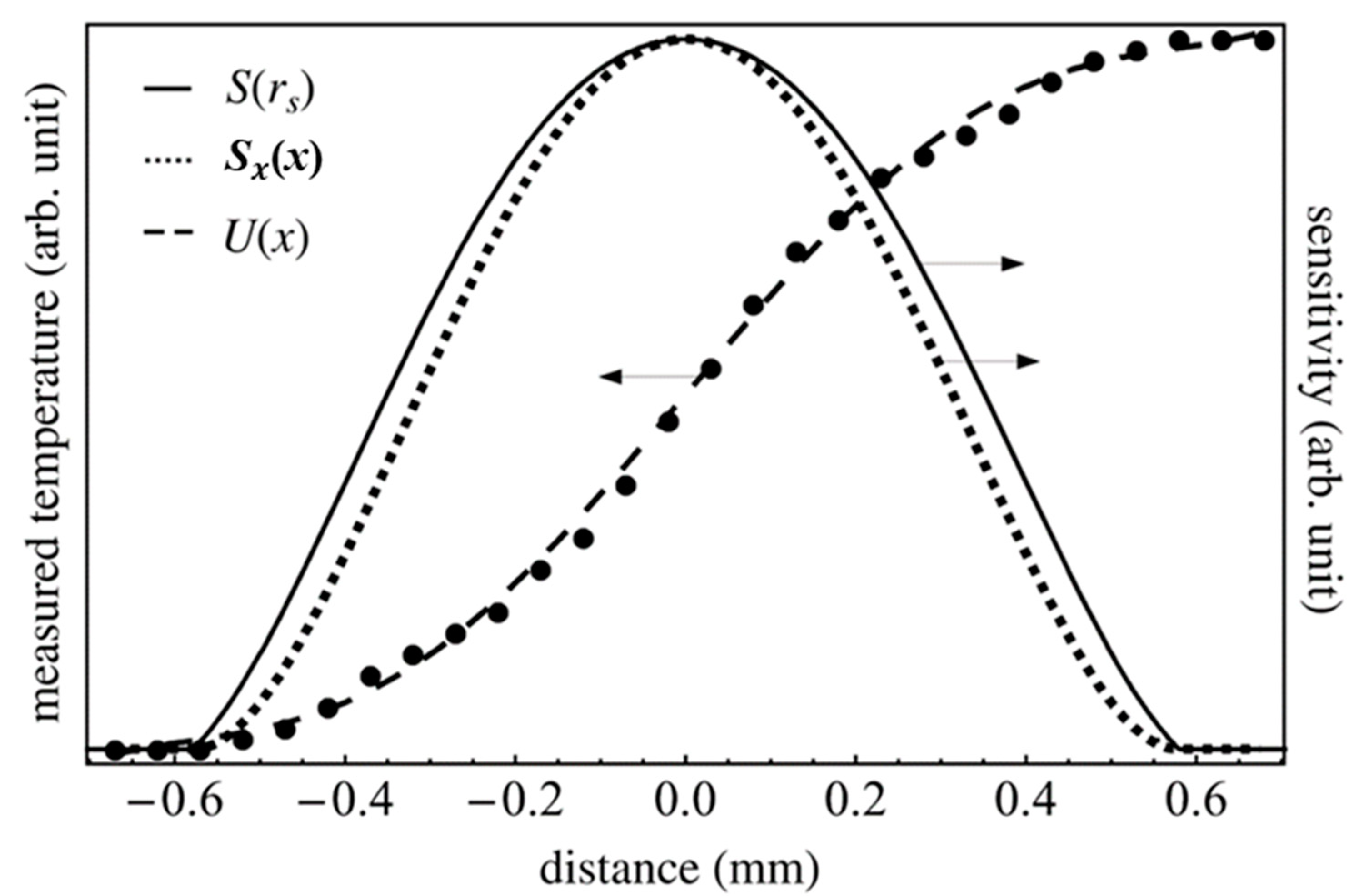

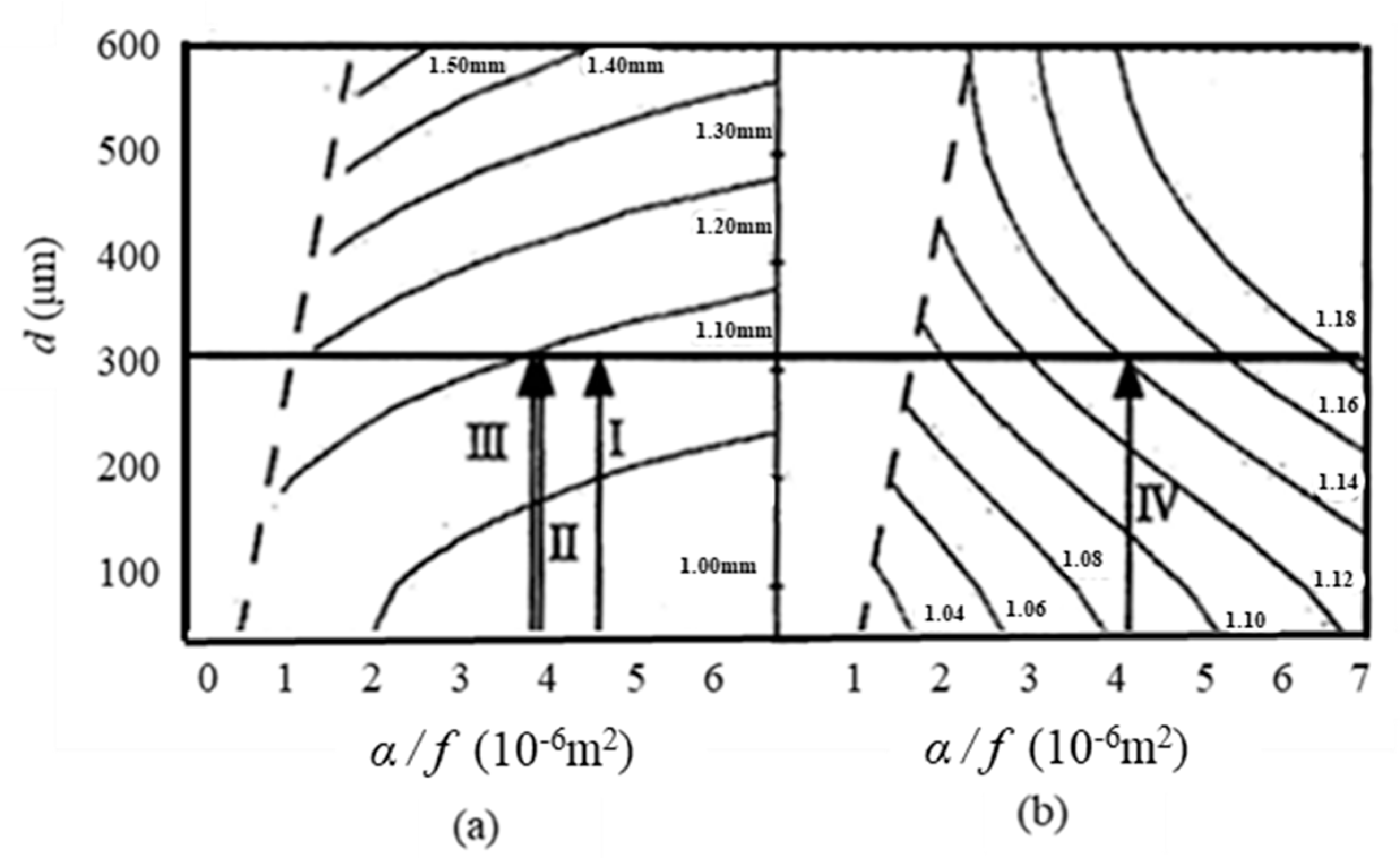
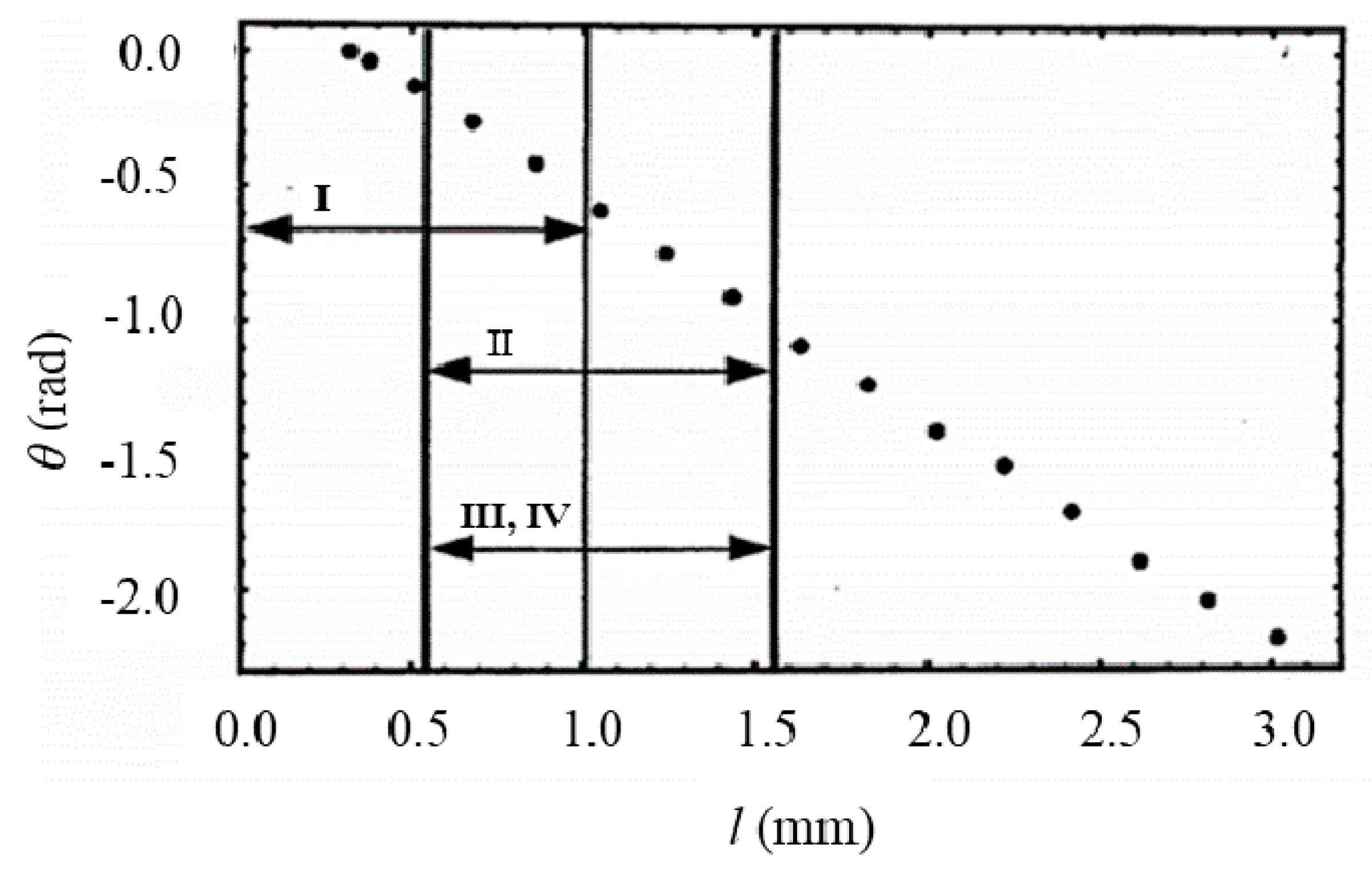
Publisher’s Note: MDPI stays neutral with regard to jurisdictional claims in published maps and institutional affiliations. |
© 2020 by the authors. Licensee MDPI, Basel, Switzerland. This article is an open access article distributed under the terms and conditions of the Creative Commons Attribution (CC BY) license (http://creativecommons.org/licenses/by/4.0/).
Share and Cite
Nagata, S.; Nishi, T.; Miyake, S.; Azuma, N.; Hatori, K.; Awano, T.; Ohta, H. Development of Novel Thermal Diffusivity Analysis by Spot Periodic Heating and Infrared Radiation Thermometer Method. Materials 2020, 13, 4848. https://doi.org/10.3390/ma13214848
Nagata S, Nishi T, Miyake S, Azuma N, Hatori K, Awano T, Ohta H. Development of Novel Thermal Diffusivity Analysis by Spot Periodic Heating and Infrared Radiation Thermometer Method. Materials. 2020; 13(21):4848. https://doi.org/10.3390/ma13214848
Chicago/Turabian StyleNagata, Sho, Tsuyoshi Nishi, Shugo Miyake, Naoyoshi Azuma, Kimihito Hatori, Takaaki Awano, and Hiromichi Ohta. 2020. "Development of Novel Thermal Diffusivity Analysis by Spot Periodic Heating and Infrared Radiation Thermometer Method" Materials 13, no. 21: 4848. https://doi.org/10.3390/ma13214848
APA StyleNagata, S., Nishi, T., Miyake, S., Azuma, N., Hatori, K., Awano, T., & Ohta, H. (2020). Development of Novel Thermal Diffusivity Analysis by Spot Periodic Heating and Infrared Radiation Thermometer Method. Materials, 13(21), 4848. https://doi.org/10.3390/ma13214848



